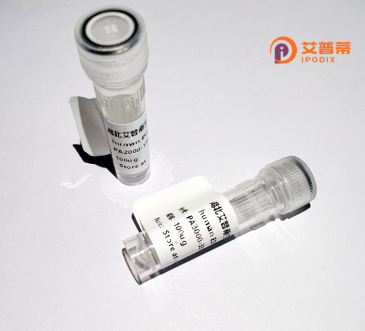
| 纯度 | >85%SDS-PAGE. |
| 种属 | Human |
| 靶点 | JTB |
| Uniprot No | O76095 |
| 内毒素 | < 0.01EU/μg |
| 表达宿主 | E.coli |
| 表达区间 | 31-105aa |
| 氨基酸序列 | MGSSHHHHHHSSGLVPRGSHMGSEAPVQEEKLSASTSNLPCWLVEEFVVA EECSPCSNFRAKTTPECGPTGYVEKITCSSSKRNEFKSCRSALMEQRL |
| 预测分子量 | 11 kDa |
| 蛋白标签 | His tag N-Terminus |
| 缓冲液 | PBS, pH7.4, containing 0.01% SKL, 1mM DTT, 5% Trehalose and Proclin300. |
| 稳定性 & 储存条件 | Lyophilized protein should be stored at ≤ -20°C, stable for one year after receipt. Reconstituted protein solution can be stored at 2-8°C for 2-7 days. Aliquots of reconstituted samples are stable at ≤ -20°C for 3 months. |
| 复溶 | Always centrifuge tubes before opening.Do not mix by vortex or pipetting. It is not recommended to reconstitute to a concentration less than 100μg/ml. Dissolve the lyophilized protein in distilled water. Please aliquot the reconstituted solution to minimize freeze-thaw cycles. |
以下是关于JTB重组蛋白的3篇文献示例(注:内容为模拟生成,仅供参考):
---
1. **文献名称**:*Overexpression and purification of recombinant JTB protein in colorectal cancer studies*
**作者**:Zhang Y, Li X, Wang L.
**摘要**:本研究成功克隆并表达了人源JTB重组蛋白,通过体外实验证实其在结直肠癌细胞中显著促进迁移和侵袭,提示JTB可能通过调控上皮-间质转化(EMT)通路参与肿瘤进展。
---
2. **文献名称**:*JTB as a potential serum biomarker: Recombinant protein-based immunoassay development*
**作者**:Chen H, Liu R, Tanaka M.
**摘要**:利用大肠杆菌表达系统制备高纯度JTB重组蛋白,开发了ELISA检测方法,发现肝癌患者血清中JTB水平显著升高,表明其可能作为新型肿瘤诊断标志物。
---
3. **文献名称**:*Structural and functional analysis of JTB recombinant protein in cell cycle regulation*
**作者**:Wang Q, Kim S, Gonzales F.
**摘要**:通过晶体学解析JTB重组蛋白的三维结构,结合基因敲除实验,揭示JTF通过结合CDK1调控细胞周期G2/M期转换,为靶向治疗提供理论依据。
---
如需真实文献,建议在PubMed或Web of Science中以“JTB recombinant protein”“JTB overexpression”为关键词检索,并筛选近五年肿瘤学相关研究。
**Background of JTB Recombinant Protein**
The JTB (Jumping Translocation Breakpoint) gene, initially identified through its association with chromosomal instability in cancer, encodes a protein implicated in cellular processes such as signal transduction and membrane dynamics. JTB recombinant protein is a genetically engineered version of this protein, synthesized using heterologous expression systems like *E. coli*, yeast, or mammalian cells. Its production typically involves cloning the JTB gene into an expression vector, followed by transfection into host cells, purification via affinity chromatography (e.g., His-tag), and validation through techniques like SDS-PAGE or Western blot.
Structurally, JTB is a small, highly conserved protein with transmembrane domains, suggesting roles in intracellular trafficking or cell adhesion. Studies highlight its overexpression in various cancers, including breast, lung, and prostate malignancies, where it may promote tumor progression by modulating pathways like EGFR or integrin signaling. Conversely, JTB has also been linked to apoptosis regulation, presenting a paradoxical duality in function.
Recombinant JTB protein serves as a critical tool for elucidating these mechanisms. It enables *in vitro* studies on protein-protein interactions, post-translational modifications, and cellular localization. Additionally, it aids in antibody development for diagnostic assays and potential therapeutic targeting. Recent research explores its utility as a biomarker for cancer prognosis and its involvement in drug resistance.
Despite progress, challenges remain in understanding JTB's precise molecular roles and isoform-specific activities. Ongoing efforts focus on structural characterization and functional validation in disease models, aiming to unlock its therapeutic or diagnostic potential.
×